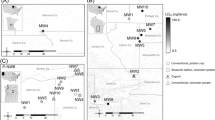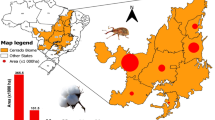Abstract
Test kits were developed to enable growers to assess insecticide resistance in Colorado potato beetle populations. Kits included tests for resistance to: carbofuran (Furadan® 4F), phosmet (Imidan® 50WP), esfenvalerate (Asana® 1.9EC), and a combination of esfenvalerate & piperonyl butoxide (Butacide® 8EC). Tests were petri dishes containing filter paper treated with a discriminating concentration of insecticide (i.e., kills susceptible beetles but not resistant beetles). Discriminating concentrations were determined by testing susceptible and resistant strains of beetle across a range of insecticide concentration. About 200 test kits were distributed during the summer of 1988. Results received indicate: 1) Michigan beetle populations were either susceptible or highly resistant to carbofuran, 2) phosmet resistance was more widespread than previously thought, 3) many populations showed moderate to high levels of resistance to esfenvalerate, and 4) adding piperonyl butoxide reduced resistance to esfenvalerate, in many, but not all populations. Resistance kits help growers determine if insecticide resistance is present in beetle populations (either prior to or after an insecticide application), and also generate data useful to research and extension personnel in documenting the extent and distribution of resistance.
Compendio
Se desarrollaron equipos de pruebas para permitir a los productores determinar la resistencia a los insecticidas en poblaciones del escarabajo de la papa de Colorado. Los equipos incluían pruebas para resistencia a : carbofuran (Furadan® 4F), Phosmet (Imidan® 50WP), esfenvalerato (Asana® 1,9EC), y una combinación de esfenvalerato & piperonil butocida (Butocide® 8EC). Las pruebas consistieron en platos de petri conteniendo papel de filtro tratado con una concentracion diferencial de insecticida (mata a escarabajos susceptibles, pero no a los resistentes). Las concentraciones diferenciales fueron determinadas probando variantes susceptibles y resistentes del escarabajo en varias concentraciones de los insecticidas. Durante el verano de 1988 se distribuyeron cerca de 200 equipos. Los resultados obtenidos indican: 1) Las poblaciones de escarabajos de Michigan fueron susceptibles o altamente resistentes a carbofuran, 2) la resistencia a phosmet fue más difundida que lo esperado, 3) muchas poblaciones mostraron niveles de resistencia de moderados a altos a esfenvalerato, y 4) la adición de piperonil butocida redujo la resistencia a esfenvalerato, en muchas, pero no en todas las poblaciones. Los equipos ayudan a los productores a determinar si la resistencia a los insecticidas se encuentra presente en las poblaciones de escarabajos (antes o después de una aplicación de insecticidas), y también generan información util al personal de investigación y extensión, para documentar la extensión y distributión de la resistencia.
Similar content being viewed by others
Literature Cited
Brattson, L.B., C.W. Holyoke, Jr., J.R. Leeper and K.F. Raffa. 1986. Insecticide resistance: Challenge to pest management and basic research. Science 231:1255–1260.
Dennehy, T.J., J.Granett and T.F. Leigh. 1983. Relevance of slide-dip and residual bioassay comparisons to detection of resistance in spider mites. J Econ Entomol 76:1225–1230.
Dennehy, T.J. and J. Granett. 1984. Monitoring dicofol-resistant spider mites (Acari: Tetranychidae) in California cotton. J Econ Entomol 77:1386–1392.
Ferro, D.N. 1985. Pest status and control strategies of the Colorado potato beetle.In: Proceedings of the symposium of the Colorado potato beetle, XVIIth International Congress of Entomology. Massachusetts Agricultural Experiment Station Bulletin Number 704. University of Massachusetts at Amherst.
Forgash, A.J. 1981. Insecticide resistance of the Colorado potato beetle,Leptinotarsa decemlineata (Say), pp 34–46.In: J.H. Lashomb and R. Casegrande (Eds.), Advances in potato pest management. Hutchinson Ross Publ Co Stoudsburg, PA.
-1985. Insecticide resistance in the Colorado potato beetle.In: Proceedings of the symposium on the Colorado potato beetle, XVIIth International Congress of Entomology. Massachusetts Agricultural Experiment Station Bulletin Number 704. University of Massachusetts at Amherst.
Gauthier, N.L., R.N. Hofmaster and M. Semel. 1981. History of Colorado potato beetle control, pp 13–33.In: J.H. Lashomb and R. Casegrande (Eds.), Advances in potato pest management. Hutchinson Ross Publ Co Stoudsburg, PA.
Grafius, E., P. Ioannidis and B. Bishop. 1987. Colorado potato beetle management. 1987 Michigan Potato Research Report. Michigan State University Agricultural Experiment Station. Vol. 19:73–84.
Roush, R.T. and G.L. Miller. 1986. Considerations for design of insecticide resistance monitoring programs. J Econ Entomol 79:293–298.
SAS Institute, 1982. SAS user’s guide: statistics. SAS Institute, Cary, N.C.
Sokal, R.R. and F.J. Rohlf. 1981. Biometry. W.H. Freeman & Co., New York.
Author information
Authors and Affiliations
Rights and permissions
About this article
Cite this article
Bishop, B.A., Grafius, E. An on-farm insecticide resistance test kit for colorado potato beetle (Coleoptera: chrysomelidae). American Potato Journal 68, 53–64 (1991). https://doi.org/10.1007/BF02893341
Accepted:
Issue Date:
DOI: https://doi.org/10.1007/BF02893341




